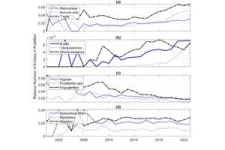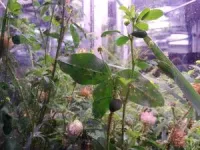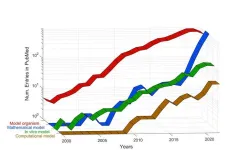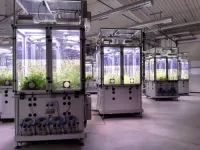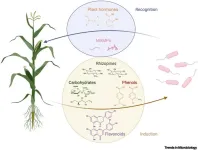(Press-News.org) A research team at the University of Liverpool has developed a new material that captures coronavirus particles and could transform the efficiency of face masks and other filter equipment to stop the spread of COVID-19 and other viruses.
In a paper published in the journal Nature Communications, the team showed that the new material used in a conventional face mask was approximately 93% more efficient at capturing proteins, including coronavirus proteins, with little impact on breathability.
The Liverpool scientists behind the new material are Professor Peter Myers, a research leader in chromatography, and Dr Simon Maher, a mass spectrometry expert.
They had been collaborating on high performance liquid chromatography processes where proteins “stick” to the surface of the chromatographic support materials.
During the pandemic, Professor Myers realised that reversing this process would provide a way to absorb proteins, and specifically the protruding S1 spike protein which covers the outer lipid membrane of the SARS-CoV-2 virus.
Working together, the team from the University of Liverpool’s Department of Chemistry and Electrical Engineering and Electronics, “re-tuned” the surface of the spherical silica particle they used for chromatography to make the surface very “sticky” for the COVID-19 S1 spike protein.
At the same time, they increased the porosity of the silica particle to give it a very large surface area of 300m2 per gram, which is approximately the same area as a tennis court. Furthermore, they increased the internal volume of the silica sphere to provide a large capacity to “capture” the virus.
The new material is at proof of concept stage and the team has shown it works in face masks in addition to air filters such as those used in aeroplanes, cars and air conditioning.
The group, which includes the Liverpool School of Tropical Medicine, also developed a method to attach the sticky particles onto the surface of a conventional face mask.
Professor Peter Myers said: “This proof of concept research has only scratched the surface and whilst COVID-19 is no longer a global threat to our health, this material has the potential to be used in a wide range of applications. Our research team is looking at developing more advanced “sticky” surfaces for a variety of bioaerosols including the new Covid variant BA.2.86 as well as influenzas and other deadly viruses such as Nipah.”
The paper `Attaching protein-adsorbing silica particles to the surface of cotton substrates for bioaerosol capture including SARS-CoV-2‘ (doi:10.1038/s41467-023-40696-x ) is published in Nature Communications.
END
New material captures coronavirus particles and could transform face mask efficiency
University of Liverpool researchers develop a new material that captures coronavirus particles and could transform the efficiency of face masks,
2023-09-26
ELSE PRESS RELEASES FROM THIS DATE:
Optimizing treatment for acute spinal cord injury
2023-09-26
New Rochelle, NY, September 26, 2023—A special focus issue of the peer-reviewed Journal of Neurotrauma highlights the latest findings of the North American Clinical Trials Network (NACTN), aimed at improving outcomes for individuals with acute spinal cord injury (SCI). Click here to read the issue now.
Led by Guest Editor Michael Fehlings, MD, PhD, from Toronto Western Hospital, the focus issue includes an article on the history and accomplishments of the NACTN, which is a consortium of translational clinical research centers with the overarching aim to translate scientific discoveries in the realm of SCI neuroprotection and neuroregeneration while ...
Determining the meaning of a ‘model’
2023-09-26
The term model is employed quite widely in science and technology.
Researchers in disciplines such as biology, computing, engineering and mathematics each have their own understanding and meaning of what a model is meant to be.
In a timely paper published in the journal Cancers, City, University of London Biomedical Imaging academic, Dr Constantino Carlos Reyes Aldasoro, reviews the use of the word model as it relates to cancer research and the specific area of the microenvironment surrounding a cancer tumour.
He then groups different definitions ...
Decreasing biodiversity may promote spread of viruses
2023-09-26
How are environmental changes, loss of biodiversity, and the spread of pathogens connected? The answer is a puzzle. Scientists from Charité – Universitätsmedizin Berlin in cooperation with the Leibniz Institute for Zoo and Wildlife Research (Leibniz-IZW) have now described one piece of that puzzle in the journal “eLife”, showing that the destruction of tropical rainforests harms the diversity of mosquito species. At the same time, more resilient species of mosquitoes become more prevalent – which also means the viruses they carry are more abundant. If there are many individuals of a given ...
Effect of combined alcohol and e-cigarette use on blood brain barrier under study at Lewis Katz School of Medicine at Temple University thanks to new NIH grant
2023-09-26
With a variety of flavors and widespread perceptions of safety, e-cigarettes appeal to an array of users and especially to adolescents. E-cigarette use, however, is linked to increased alcohol consumption, as well as the use of other substances and drugs. The health effects of such combinations remain almost entirely unknown.
Now, with new funding from the National Institute on Alcohol Abuse and Alcoholism (NIAAA) of the National Institutes of Health (NIH), researchers at the Lewis Katz School of Medicine at Temple University hope ...
Suicide risks of health care workers in the US
2023-09-26
About The Study: From a nationally representative cohort of approximately 1.84 million employed adults observed from 2008 through 2019, relative to non–health care workers, registered nurses, health technicians, and health care support workers in the U.S. were at increased risk of suicide. New programmatic efforts are needed to protect the mental health of these U.S. health care workers.
Authors: Mark Olfson, M.D., M.P.H., of Columbia University in New York, is the corresponding author.
To access the embargoed study: Visit our For ...
Premorbid sociodemographic status and multiple sclerosis outcomes with universal health care
2023-09-26
About The Study: In this study of working-age adults with multiple sclerosis (MS), premorbid income, education, and marital status correlated with disability and symptom severity in relapse onset and progressive-onset MS, independent of treatment. These findings suggest that socioeconomic status may reflect both structural and individual determinants of health in MS.
Authors: Anna He, M.B.B.S., of the Karolinska Institute in Stockholm, Sweden is the corresponding author.
To access the embargoed study: Visit our ...
Alcohol use and sustained virologic response to hepatitis C virus direct-acting antiviral therapy
2023-09-26
About The Study: In this study of 69,000 adults with hepatitis C virus (HCV) infection, there was no difference in sustained virologic response across alcohol use categories, even for patients with high-risk consumption or alcohol use disorder, after adjusting for potential confounding variables. These findings suggest that restricting access to direct-acting antiviral therapy on the basis of alcohol use creates an unnecessary barrier for patients and challenges HCV elimination goals.
Authors: Emily J. Cartwright, M.D., of the Emory University School of Medicine in Atlanta, ...
Earthworms contribute to 6.5% of global grain production, according to new CSU research
2023-09-26
Earthworms are important drivers of global food production, contributing to approximately 6.5% of grain yield and 2.3% of legumes produced worldwide each year, according to new work published by Colorado State University scientists in the journal Nature Communications.
These new estimates from a trio of CSU researchers mean earthworms may account for as much as 140 million metric tons of food produced annually — roughly comparative to the amount of cereal grains (rice, wheat, rye, oats, barley, maize and millet) ...
Invertebrate decline reduces natural pest control and decomposition of organic matter
2023-09-26
Leipzig. The decline in invertebrates also affects the functioning of ecosystems, including two critical ecosystem services: aboveground pest control and belowground decomposition of organic material, according to a new study published in Current Biology and led by researchers at the German Centre for Integrative Biodiversity Research (iDiv) and Leipzig University. The study provides evidence that loss of invertebrates leads to a reduction in important ecosystem services and to the decoupling of ecosystem processes, making immediate protection measures necessary.
Invertebrates, such as insects and also ...
Genetically engineering associations between plants and nitrogen-fixing microbes could lessen dependence on synthetic fertilizer
2023-09-26
Nitrogen is an essential nutrient for plant growth, but the overuse of synthetic nitrogen fertilizers in agriculture is not sustainable. In a review article publishing in the journal Trends in Microbiology on September 26, a team of bacteriologists and plant scientists discuss the possibility of using genetic engineering to facilitate mutualistic relationships between plants and nitrogen-fixing microbes called “diazotrophs.” These engineered associations would help crops acquire nitrogen from the air by mimicking the mutualisms between legumes and nitrogen-fixing bacteria.
“Engineering associative diazotrophs to provide nitrogen ...
LAST 30 PRESS RELEASES:
Post-stroke injection protects the brain in preclinical study
Cardiovascular risk score predicts multiple eye diseases
Health: estimated one in ten British adults used or interested in GLP-1 medications for weight loss
Exercise to treat depression yields similar results to therapy
Whooping cough vaccination for pregnant women strengthens babies’ immune system
Dramatic decline in new cases of orphanhood in Uganda driven by HIV treatment and prevention programs
Stopping weight loss drugs linked to weight regain and reversal of heart health markers
Higher intake of food preservatives linked to increased cancer risk
Mass General Brigham–developed cholera vaccine completes phase 1 trial
First experimental validation of a “150-year-old chemical common sense” direct visualization of the molecular structural changes in the ultrafast anthracene [4+4] photocycloaddition reaction
Lack of support for people on weight loss drugs leaves them vulnerable to nutritional deficiencies, say experts
Dogs’ dinners can have greater climate impact than owners’
Are you ready to swap salmon for sprats and sardines?
1.6 million UK adults used weight loss drugs in past year
American College of Cardiology comments on new dietary guidelines for Americans
American Society of Gene & Cell Therapy and Orphan Therapeutics Accelerator partner to advance and commercialize promising rare disease treatments
One in 14 patients having day case surgery have new or worse chronic pain 3 months after their operation
New study highlights link between eviction rates and gun violence
Heatwaves heat up soil but not toxin levels in rice, study finds
Digital modeling reveals where construction carbon emissions really come from
Turning farm waste into water filters
New study shows how the spleen helps the immune system accept a transplant
New Mayo Clinic study advances personalized prostate cancer education with an EHR-integrated AI agent
Researchers identify novel therapeutic target to improve recovery after nerve injury
Microbes in breast milk help populate infant gut microbiomes
Reprogramming immunity to rewrite the story of Type 1 diabetes
New tool narrows the search for ideal material structures
Artificial saliva containing sugarcane protein helps protect the teeth of patients with head and neck cancer
Understanding the role of linear ubiquitination in T-tubule biogenesis
Researchers identify urban atmosphere as primary reservoir of microplastics
[Press-News.org] New material captures coronavirus particles and could transform face mask efficiencyUniversity of Liverpool researchers develop a new material that captures coronavirus particles and could transform the efficiency of face masks,

